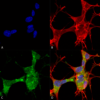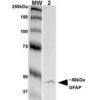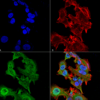Anti-GFAP Antibody (56566)
$466.00
| Host | Quantity | Applications | Species Reactivity | Data Sheet | |
|---|---|---|---|---|---|
| Mouse | 100ug | WB,IHC,ICC/IF | Human, Mouse, Rat |  |
SKU: 56566
Categories: Antibody Products, Neuroscience and Signal Transduction Antibodies, Products
Overview
Product Name Anti-GFAP Antibody (56566)
Description Anti-GFAP Mouse Monoclonal Antibody
Target GFAP
Species Reactivity Human, Mouse, Rat
Applications WB,IHC,ICC/IF
Host Mouse
Clonality Monoclonal
Clone ID S206A-8
Isotype IgG1
Immunogen Synthetic peptide corresponding to aa 411-422 (KTVEMRDGEVIK) of human GFAP. This sequence is 100
Properties
Form Liquid
Concentration 1.0 mg/mL
Formulation PBS, pH 7.4, 0.1% sodium azide, 50% glycerol.
Buffer Formulation Phosphate Buffered Saline
Buffer pH pH 7.4
Buffer Anti-Microbial 0.1% Sodium Azide
Buffer Cryopreservative 50% Glycerol
Format Purified
Purification Purified by Protein G affinity chromatography
Specificity Information
Specificity This antibody recognizes human, mouse and rat GFAP. It cross-reacts with GFAP- R416W and other GFAP mutant proteins.
Target Name Glial fibrillary acidic protein
Target ID GFAP
Uniprot ID P14136
Alternative Names GFAP
Gene Name GFAP
Sequence Location Cytoplasm
Biological Function GFAP, a class-III intermediate filament, is a cell-specific marker that, during the development of the central nervous system, distinguishes astrocytes from other glial cells.
Research Areas Neuroscience
Background Glial fibrillary acidic protein (GFAP) is a major structural component of astrocytes. Phosphorylation of GFAP, and its association with annexin II-p2 and S-100, regulates GFAP polymerization. One of the first events that occurs during astrocyte proliferation is increased GFAP expression. Antibodies to GFAP have been detected in individuals with dementia, although the significance of this has not been conclusively determined.
Application Images
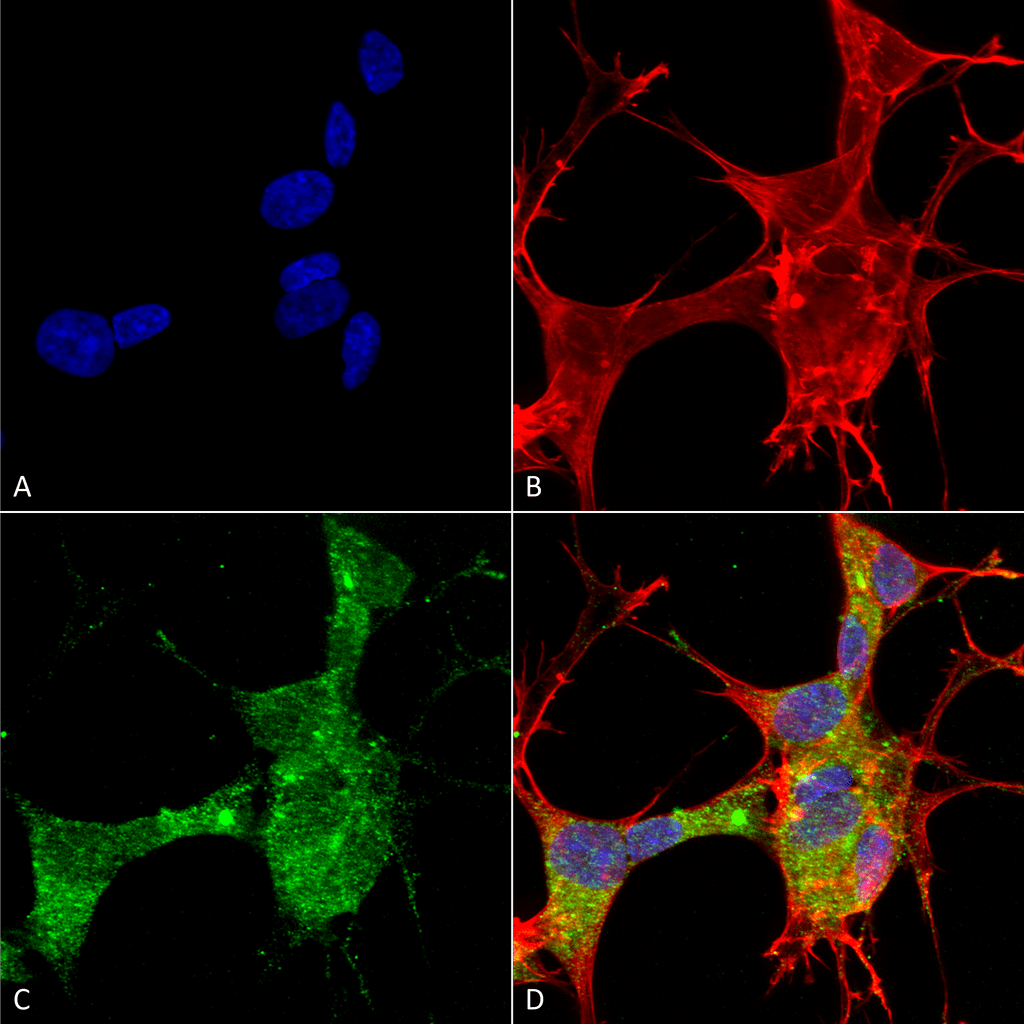
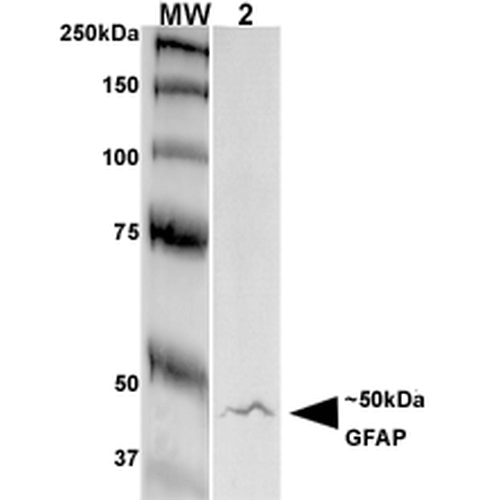
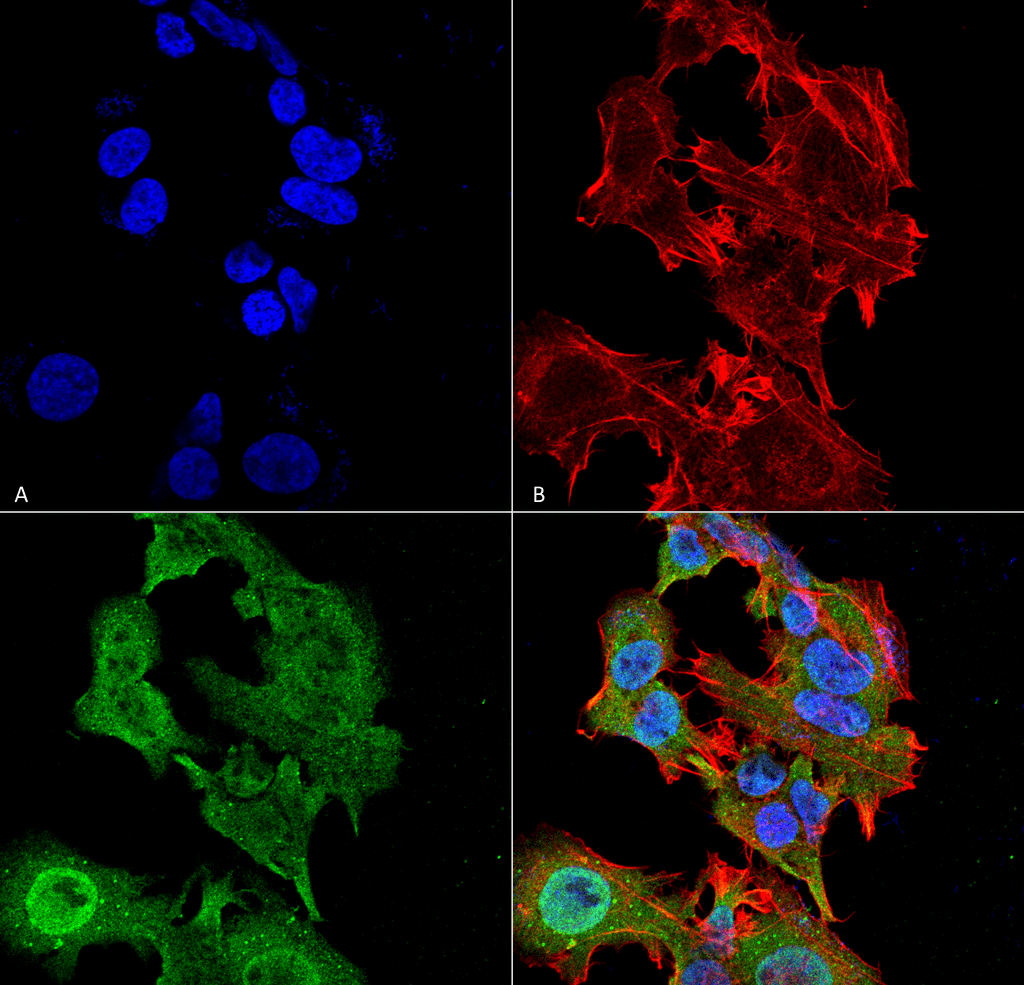

Description Immunocytochemistry/Immunofluorescence analysis using Mouse Anti-GFAP Monoclonal Antibody, Clone S206A-8 (56566). Tissue: Neuroblastoma cells (SH-SY5Y). Species: Human. Fixation: 4% PFA for 15 min. Primary Antibody: Mouse Anti-GFAP Monoclonal Antibody (56566) at 1:50 for overnight at 4°C with slow rocking. Secondary Antibody: AlexaFluor 488 at 1:1000 for 1 hour at RT. Counterstain: Phalloidin-iFluor 647 (red) F-Actin stain; Hoechst (blue) nuclear stain at 1:800, 1.6mM for 20 min at RT. (A) Hoechst (blue) nuclear stain. (B) Phalloidin-iFluor 647 (red) F-Actin stain. (C) GFAP Antibody (D) Composite.

Description Western Blot analysis of Rat Brain Membrane showing detection of GFAP protein using Mouse Anti-GFAP Monoclonal Antibody, Clone S206A-8 (56566). Primary Antibody: Mouse Anti-GFAP Monoclonal Antibody (56566) at 1:250.

Description Immunocytochemistry/Immunofluorescence analysis using Mouse Anti-GFAP Monoclonal Antibody, Clone S206A-8 (56566). Tissue: Neuroblastoma cell line (SK-N-BE). Species: Human. Fixation: 4% Formaldehyde for 15 min at RT. Primary Antibody: Mouse Anti-GFAP Monoclonal Antibody (56566) at 1:100 for 60 min at RT. Secondary Antibody: Goat Anti-Mouse ATTO 488 at 1:100 for 60 min at RT. Counterstain: Phalloidin Texas Red F-Actin stain; DAPI (blue) nuclear stain at 1:1000, 1:5000 for 60min RT, 5min RT. Localization: Cytoplasm . Magnification: 60X. (A) DAPI (blue) nuclear stain. (B) Phalloidin Texas Red F-Actin stain. (C) GFAP Antibody. (D) Composite.
Handling
Storage This product is stable for at least one (1) year at -20°C.
Dilution Instructions Dilute in PBS or medium that is identical to that used in the assay system.
Application Instructions Immunoblotting: use at 1-4ug/mL. A band of ~50kDa is detected.
Immunofluorescence: use at 10ug/mL.
These are recommended concentrations.
Endusers should determine optimal concentrations for their application.
Immunofluorescence: use at 10ug/mL.
These are recommended concentrations.
Endusers should determine optimal concentrations for their application.
References & Data Sheet
Data Sheet  Download PDF Data Sheet
Download PDF Data Sheet
 Download PDF Data Sheet
Download PDF Data Sheet




